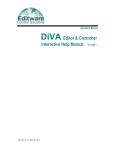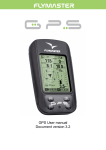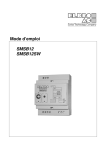Download Operating Instructions
Transcript
Operating Instructions SMSB26 SMSB26EM80 SMSB26SW Index Seite 1 2 3 Introduction _________________________________________________________________ 4 1.1 Short description _________________________________________________________ 4 1.2 Areas of application _______________________________________________________ 4 1.3 Security directives ________________________________________________________ 4 Installation __________________________________________________________________ 5 2.1 Environmental Conditions __________________________________________________ 5 2.2 Degree of Protection_______________________________________________________ 5 2.3 Power Supply ____________________________________________________________ 5 2.4 Signalling Inputs __________________________________________________________ 5 2.5 Relay Outputs ____________________________________________________________ 5 SMSB26_____________________________________________________________________ 6 3.1 Signalling LED____________________________________________________________ 7 3.2 Pushbutton ______________________________________________________________ 7 3.3 RS232 Port _______________________________________________________________ 7 3.4 Input and Output Lines_____________________________________________________ 7 3.5 Expansion Bus ___________________________________________________________ 7 4 Expansion SMSB26EM80 ______________________________________________________ 7 5 Installing the Expansion _______________________________________________________ 8 6 Installing the SMSB26 Software _________________________________________________ 9 7 Setting Up the SMSB26 Device _________________________________________________ 9 8 9 7.1 Programming Mode _______________________________________________________ 9 7.2 Connecting to the Device __________________________________________________ 9 7.3 Formatting the SIM Card ___________________________________________________ 9 7.4 Requesting the PIN safety code ____________________________________________ 10 7.5 Number of the SMS Service Centre__________________________________________ 10 7.6 System Password ________________________________________________________ 10 7.7 Master Number __________________________________________________________ 10 7.8 Privacy _________________________________________________________________ 10 7.9 Signalling Inputs _________________________________________________________ 11 7.10 Exiting from Programming Mode ___________________________________________ 11 Advanced Software Settings __________________________________________________ 12 8.1 Control Panel____________________________________________________________ 12 8.2 Saving the settings to a file ________________________________________________ 12 8.3 Loading the settings from a file_____________________________________________ 12 8.4 Printing the Setting _______________________________________________________ 12 COMMAND SMS _____________________________________________________________ 12 9.1 1 (Enable Output no.X) ____________________________________________________ 12 9.2 0 (Disable Output no.X) ___________________________________________________ 13 9.3 O [as in Oxford] (Simultaneously Change the Status of the Outputs) _____________ 13 9.4 ? (Status Request) _______________________________________________________ 13 SMSB26 Page 2 / 16 1. 10. 2005 Index 9.5 M [as in Manchester] (Change Recipient) ____________________________________ 13 10 NOTIFICATION SMS _________________________________________________________ 14 11 ERROR SMS ________________________________________________________________ 14 12 Technical Data ______________________________________________________________ 15 12.1 SMSB26 ________________________________________________________________ 15 12.2 Software SMSB26SW (Requirement) ________________________________________ 15 12.3 Accessories _____________________________________________________________ 16 13 Declaration of Conformity_____________________________________________________ 16 14 Guarantee __________________________________________________________________ 16 SMSB26 Page 3 / 16 1. 10. 2005 1 Introduction 1.1 Short description Our sincere thanks and congratulations on your purchase of the SMSB26! This high quality device, when combined with a mobile (cell phone) will make your life easier: Remote switching: Allows transmitting an SMS from your mobile to the SMSB26 to switch devices on or off. Example: Heating in a holiday flat. Remote alarm signalization: Notification via SMS if there is a change in an operational status being monitored by the SMSB26. Example: An alarm system. Remote interrogation: Per SMS you can interrogate the switch status of the relays and the inputs at any time. Additional product features: To switch and interrogate the SMSB26, the user must know the password of the device (stored on the SIM card). Easy mounting of the compact plastic housing on a DIN top hat rail. Communication with a PC via the easily accessible serial interface at the top of the SMSB26. Optional SMSB26SW software considerably simplifies system configuration. Configuration without software is possible, but it is not recommended! 1.2 Areas of application Building supervision Industrial systems Pumping stations water supply systems Traffic systems / Railway systems / Vehicles Energy systems Water clarification plants Heating power plants 1.3 Security directives Installation of the SMS Switch Butler must be carried out by trained personnel. The SIM card owner is exclusively responsible for protection against misuse. Momentary system status is retained upon power failure. SMSB26 Page 4 / 16 1. 10. 2005 2 Installation In order to ensure the operator's safety and the correct operation of the device you have purchased, the SMSB26 device is to be installed exclusively by qualified staff. The rules listed below are also to be strictly respected. 2.1 Environmental Conditions The SMSB26 device (the device and all cables connected to it) are to be installed in places free of, or far from: Dust, damp, intense heat; Direct exposure to the sunlight; Objects that radiate heat; Objects that generate a strong electromagnetic field; Liquids or corrosive chemical substances The SMSB26 device was designed to operate at a temperature of between -5°C and +45°C (standard working temperature). Avoid sudden changes in temperature and/or humidity. 2.2 Degree of Protection During the installation of the SMSB26 device, the following degree of protection is to be ensured: IP40: minimum protection, must always be guaranteed; IP54: protection to be guaranteed when using the device outdoors. 2.3 Power Supply Respect the following rules: Do not use cables longer than 3 m; Do not invert the polarity of the power supply cables. 2.4 Signalling Inputs During the installation of the device, the indications given in the section describing the signalling inputs must be strictly respected. Respect the polarities and ratings indicated in the manual. 2.5 Relay Outputs During the installation of the device, the indications given in the section describing the relay outputs must be strictly respected. Install the devices correctly and respect the ratings indicated in this manual. Never exceed the ratings for any reason whatsoever. SMSB26 Page 5 / 16 1. 10. 2005 3 SMSB26 RELAY RELEASE / PROGRAMMING BUTTON SIM CARD HOLDER CLEAN CONTACT SIGNALLING INPUTS OPTOCOUPLED SIGNALLING INPUTS RS232 PORT EXPANSION BUS RELAY OUTPUTS ANTENNA CONNECTOR POWER SUPPLY INPUT STATUS LED “rest” position: NC-COM nominal commutation capacity: 6A 250V AC minimum commutation capacity: 100mA 12V DC max cables length: 3m. Respect the polarities that are shown on the side. Rating: o 0÷5V DC o Imax=30mA Status: o ON: 5V DC o OFF: 0V DC At each input it’s possibile to assign until 5 sms to the trasition ONOFF and OFFON. DIGITAL INPUTS It is possible to connect: o Mechanical and electromechanical switches having adequate rating: 5V DC min 50µA o Electronic switches having adequate rating: 5V DC min 50µA. Respect the polarity that is shown on the side Status: o ON: closet o OFF: open At each input it’s possibile to assign until 5 sms to the trasitions ONOFF and OFFON. CLEAN CONTACT INPUTS OUTPUTS 9÷30V DC; Imax=500mA; Max cables lenght: 3m.verwenden. POWER SUPPLY 3.1 Signalling LED The information given by the LED are the following: LED STATUS DEVICE STATUS Off Device turned Off The LED is blinking with long duration flashes (the LED is almost always on) the SIM card is not properly inserted; the SIM is protected by PIN code; network search in progress or network login in progress; The LED is blinking with very short duration flashes (the LED is almost always off) On The device logged to GSM network and ready to receive commands A data transfer connection is in progress 3.2 Pushbutton This pushbutton can be used to: return all the relay outputs managed by the SMSB26 device to their rest condition during normal operation of the device (NC and COM contacts short-circuited); program the SMSB26 device during the installation phase. 3.3 RS232 Port The RS232 port is used during installation to connect the SMSB 26 device to a PC (using the proprietary data cable provided) and to set the set-up parameters using the configuration software. 3.4 Input and Output Lines At the end of the programming procedure, the status of the SMSB 26 device signalling inputs is considered as the current status of the signalling lines. The device stores all changes made to the input and output lines. In the case of a power failure, when power is restored, the device restores the output to the last known status and manages any new requests for the transmission of signalling SMS messages. 3.5 Expansion Bus An expansion for increasing the number of output lines from 2 to 10 may be connected to the BUS connector. 4 Expansion SMSB26EM80 The SMSB26 device is capable of controlling an expansion with eight output lines. The ratings for the relay outputs are: Rated switching capacity: 6 A 250V AC; Minimum switching capacity: 100mA 12V AC. SMSB26 Page 7 / 16 1. 10. 2005 N.B.: respect ratings indicated in this section! OUTPUT 7 OUTPUT 8 OUTPUT 9 OUTPUT 10 OUTPUT 6 OUTPUT 5 OUTPUT 4 OUTPUT 3 Pin n° DESCRIPTION 1 2 3 4 5 6 7 8 9 10 11 12 13 14 15 16 17 18 19 20 21 22 23 24 25 NOT USED NO OUTPUT 3 COM U3 NC NC OUTPUT 4 COM U4 NO NO OUTPUT 5 COM U5 NC NC OUTPUT 6 COM U6 NO NO OUTPUT 7 COM U7 NC NC OUTPUT 8 COM U8 NO NO OUTPUT 9 COM U9 NC NC OUTPUT 10 COM U10 NO The first time the SMSB26 device is started, all the relay outputs of the SMSB26 device and the output expansions have the contacts set to NC and COM (relay coils not energized). After a reset due to a power failure, the status of the relays present on the expansion is restored after about 10 sec. Before being reset, all the relays have their contacts set to NC and COM. . 5 Installing the Expansion The expansion may be installed during the installation of the SMSB26 device or subsequently. The general procedure to be carried out to install the device is the following: turn off the SMSB26 device; connect the expansion to the SMSB26 device using the included cable: o insert one end of the connecting cable in the socket on the front panel of the SMSB26 device indicated by the word BUS; o insert the other end of the cable in either of the sockets on the front panel of the expansion that is to be installed. follow the programming procedure indicated in the “Setting Up the SMSB26 Device" chapter. SMSB26 Page 8 / 16 1. 10. 2005 6 Installing the SMSB26 Software 1. Insert the SMSB26 Software CD in the CD-ROM drive; 2. In the SMSB26 Software window, click on Install SMSB26 Software.; 3. If the computer is not set to start the CD automatically, it must be started manually; 4. Click on Next and follow the instructions that appear on the screen. Important: During the software installation procedure, it may be necessary to install Microsoft .NET Framework 1.1. Before starting the program, read the sections describing the procedure for programming the SMSB26 device. 7 Setting Up the SMSB26 Device For the SMSB26 device to be able to work properly, the following procedure is to be carried out: 1. Start the SMSB26 device in “programming mode”; 2. Start the program and connect to the device; 3. Format the SIM Card inserted in the device; 4. Enter the set-up parameters and download them to the device; 5. Exit from “programming mode” on the SMSB26 device. 7.1 Programming Mode 1. Turn off the SMSB26 device; 2. Insert the SIM Card in its bay; 3. Connect the proprietary RS232 data cable to the device’s programming port; 4. Connect the RS232 data cable to the relevant port of the PC; 5. Press and hold down the “Relays Off” button on the front panel of the device; 6. Power on the device; 7. As soon as the power LED starts to blink, release the button. 7.2 Connecting to the Device 1. Start the software; 2. Click on the “Settings” menu; 3. Select the “Serial Port” menu; 4. Set the communication port (COM) to which the SMSB26 device is connected; 5. Click on “Apply” and then “OK”; 6. From the “Connection” menu, select “Connect”. To ensure that the SMSB 26 device functions properly, the device is only to be connected when in programming mode. Having made the connection and formatted the SIM card, you can enter the parameters described here below. 7.3 Formatting the SIM Card Having connected to the device, click on the “Format the SIM” button to erase all the data from the SIM Card. SMSB26 Page 9 / 16 1. 10. 2005 7.4 Requesting the PIN safety code If your SIM Card is protected by a PIN code, the software will automatically display a screen on which to enter the PIN code. Once it has been entered, the code will be disabled permanently. If the SIM card is locked following 3 failed attempts to enter the incorrect PIN code, the program prompts you to enter the PUK code and a new PIN code. Warning: If an incorrect PUK number is entered 10 times, the SIM card will be locked permanently. 7.5 Number of the SMS Service Centre Select Settings “SMS Service Centre address”. If the current number does not appear, enter the Number of the Service Centre of the operator of the SIM Card inserted in the device. 7.6 System Password The SMSB26 device is protected by a password made up of four decimal figures (from 0 to 9). Enter the password in the relevant field. 7.7 Master Number When the SMSB 26 device receives a command, it executes it (if correct), and sends a notification SMS to the sender’s mobile phone number. If the “Info to Master” option is active, a copy of the notification SMS is also sent to the Master (only for command 0, 1 or O). If the “Info to Master” option is enabled, the Master’s telephone number must be entered (complete with the international code). 7.8 Privacy If disabled, the SMSB26 device sends a copy of the notification SMS to the master user, indicating also the telephone number of the user who changed the status of the output and the date and time at which the command was received (see NOTIFICATION SMS). SMSB26 Page 10 / 16 1. 10. 2005 7.9 Signalling Inputs The device has 6 signalling inputs. Two events are associated with each input: “closure”: OFFON transition. “opening”: ONOFF transition. The end user may associate a minimum of zero (0) to a maximum of five (5) SMS messages to each event. The end user may freely choose the text of a signalling SMS (maximum length 15 characters) and the recipient. 1. Select the “Signalling inputs” folder. 2. Select the desired signalling input on the vertical bar on the left. 3. Enter the telephone numbers (with international code) of the users and the texts of the signalling SMS messages. 4. Check that the enabled SMS messages have no incomplete fields. 5. Having entered all the desired SMS messages, return to the “Configuration” folder. 7.10 Exiting from Programming Mode To bring the settings into effect, you must download the data to the SMSB 26 device and exit from programming mode. Before proceeding, check carefully that all fields are correctly filled in. To download the data to the device: 1. Select the “Configuration” folder. 2. Click on the “Download data” button on the control panel. 3. Wait for the end of the programming phase. To exit from programming mode and start to use the device, proceed as follows: 1. Select Disconnect from the Connection menu; 2. Disconnect the proprietary data cable from the device; 3. Press the “Relays Off” button on the front panel of the device. Having exited from programming mode, wait one minute before sending commands to the device. Important: for the device to work properly, you must exit from programming mode. SMSB26 Page 11 / 16 1. 10. 2005 8 Advanced Software Settings Important: in order to use the functions described below, the device must be in programming mode and connected to a PC. 8.1 Control Panel The program’s “Control Panel” has three buttons: 1. Import Data: used to import data from a programmed device; 2. Download Data: used to transfer the set-up parameters to the device; 3. Format SIM card: used to erase all data from the device. 8.2 Saving the settings to a file Make sure you have entered all the necessary information correctly. 1. Click on the “File” menu. 2. Select the “Save” menu. 3. Write the name of the file. 4. Click on the “Save” button. 8.3 Loading the settings from a file Make sure you have saved a settings file previously. 1. Click on the “File” menu. 2. Select the “Open” menu. 3. Select the desired settings file. 4. Click on the “Open” button. 8.4 Printing the Setting Make sure you have installed a printer. 1. Click on the “File” menu. 2. Select the “Print…” menu or “Print Preview”. 3. Click on the “Print” button. 9 COMMAND SMS The commands that may be sent to the SMSB 26 device are: 1 : Enable Output no.X; 0 : Disable Output no.X; O or o : Change status of all outputs; ? : Request status; M or m : Change recipient of signalling SMS associated with input no.X. The format of a command SMS message is: * PASSWORD # COMAND (parameters) where PASSWORD is the password set. 9.1 1 (Enable Output no.X) * PASSWORD # 1 # X 1 : is the Enable output command (contacts on NO-COM); X : is the number of the output to be enabled (from 1 to 10, from 1 to 2 if the expansion is not present). SMSB26 Page 12 / 16 1. 10. 2005 9.2 0 (Disable Output no.X) * PASSWORD # 0 # X 0 : is the Disable Output command (contacts on NC-COM); X : is the number of the output to be disabled (from 1 to 10, from 1 to 2 if the expansion is not present). 9.3 O [as in Oxford] (Simultaneously Change the Status of the Outputs) Without expansion: * PASSWORD With expansion: * PASSWORD O or o UX # # O O # # U1 U1 U2 U2 # U3 U4 U5 U6 U7 U8 U9 U10 : is the Simultaneously Change the Status of the Outputs command : is the status of output no.X, in particular: --> UX = 1 contacts on NO-COM; --> UX = 0 contacts on NC-COM; This command is used to change the status of all relay outputs present simultaneously. 9.4 ? (Status Request) * PASSWORD ? # ? : is the Status Request command. This command is used to request the current status of the input and output lines of the device and the expansion (if present). 9.5 M [as in Manchester] (Change Recipient) * PASSWORD # M Input “ Curr_Numb “ , “ New_Numb M or m : is the Change Recipient command. Input : is the number of the signalling input. Curr_Numb : is the telephone number of the recipient to be eliminated (complete with international code). New_Numb : is the telephone number of the new recipient to be entered (complete with international code). Once an input line has been specified, this command is used to change the recipient of the signalling SMS messages, whose recipient is Curr_Numb, with New_Numb. The change is made both to the signalling SMS messages associated with the ONOFF transition and the OFFON transition. SMSB26 Page 13 / 16 1. 10. 2005 “ 10 NOTIFICATION SMS When the SMSB 26 device receives a command, it executes it (if correct), and sends a notification SMS message to the sender’s mobile phone number. The format of a notification SMS for commands 0, 1, ?, O, is as follows: SMSB26. Outputs: U1U2. Inputs: I1I2I3I4I5I6. or, if the expansion is present: SMSB26. Outputs: U1U2#U3U4U5U6U7U8U9U10. Inputs: I1I2I3I4I5I6. where: UX IX : represents the status of relay output no.X, and may be set to the values : 0 : contacts on NC-COM; 1 : contacts on NO-COM. : represents the status of input line no.X, and may be set to the following values. 0 : contact open, 1 : contact closed. If the Master option is active, a copy of the notification SMS message is also sent to the Master (only for command 0, 1 or O). If the Privacy option is active, the format of the copy of the notification SMS sent to the master is identical to the format of the one sent to the sender of the command. If the Privacy option is disabled, the format of the notification SMS sent to the Master is as follows: SMSB26. Outputs: U1U2. Inputs: I1I2I3I4I5I6. Command sent from: SENDER at YY/MM/DD, hh:mm:ssT or: SMSB26. Outputs: U1U2#U3U4U5U6U7U8U9U10. Inputs: I1I2I3I4I5I6. Command sent from: SENDER at YY/MM/DD, hh:mm:ssT where the new fields indicate: SENDER : is the mobile telephone number of the sender of the command SMS; YY/MM/DD, hh:mm:ssT : indicates year/month/day, hours/seconds/minutes Time Zone (e.g. 05/07/07, 12:02:35+08). If the command received is M, the format of the notification SMS is as follows: SMSB 26, entries modified: NUMBER. where: NUMBER : indicates the number of signalling SMS messages modified. Number is set to zero if no signalling SMS message is changed. 11 ERROR SMS The device can send two error SMS messages: 1. SMSB26: ERROR! 2. SMSB26: NO VALID ENTRIES! SMSB26 Page 14 / 16 1. 10. 2005 The first error SMS is sent if the format of a command SMS received is not valid: Invalid password; Invalid command; Invalid format. The second error SMS is sent if the format of command M received is correct, but the format of one (or both) telephone numbers is not valid: The number has no international code; The telephone number has fewer than 6 digits (plus +); The telephone number contains more than 20 digits (plus +); One of the two numbers is not a number in that it also contains letters. 12 Technical Data 12.1 SMSB26 GSM Section Power supply Outputs General characteristics Power consumption (typical values) EGSM 900 and GSM 1800 Dual Band Certified for GSM Phase 2/2+ Output power: o Class 4 (2W) per EGSM 900 o Class 1 (1W) per GSM 1800 SMS: MO, MT Power supply voltage: 9V÷30V DC Current: Imax = 500mA Power supply protected against short-circuiting by an internal fuse SPDT monostable relay ratings: 6A, 250V AC (Resistive) Container for EN-50022 guide, 6 modules, UL94V-0 Degree of protection: IP40 (if installed correctly) maximum wire cross section: 2.5mm2 Standby Send\Receive SMS Voltage=9V 50mA Voltage=30V 30mA 120mA 65mA 12.2 Software SMSB26SW (Requirement) Hardware CPU RAM Video CD-ROM drive Free disk space Minimum Recommended P4 1.0GHz\AMD Athlon XP1000+ 128 MBytes 256 MBytes Vga 800x600 SVGA 1024x768 4x 16x 6931 KBytes for SMSB26SW, 27 MBytes for Microsoft .NET Framework PIII 500MHz\AMD Athlon 500 Requirements for installing Microsoft .NET Framework : Microsoft Windows NT 4.0 requires Service Pack 6.0a Windows 2000, Windows 98, Windows ME, Windows NT, Windows Server 2003 or Windows XP require Microsoft Internet Explorer 5.01 or a later version. SMSB26 Page 15 / 16 1. 10. 2005 12.3 Accessories Power supply 12 V: Accumulator: SMSBNL12 SMSBA1.3 13 Declaration of Conformity Hereby, Elbro Ltd. declares that the device SMSB26 is in compliance with the essential requirements and other relevant provision of Directive 199/5/EC; as having been designed in conformity with the requirements of following Reference Standards: EN 301 489-7 V1.1.1 (2000-09) EN 301 511 V7.0.1 (2000-12) EN 60950 (2000) 14 Guarantee Elbro units are subject to strict quality controls. Nevertheless, we guarantee the unit against functional faults for a period of 12 months (valid with receipt only). Manufacturing and material faults will be corrected free of charge as long as the unit has not been opened and has been returned to us. Damage caused by mechanical influences, natural wear (e.g., lamp burn out) or improper operation are excluded from guarantee claims. If functional faults occur after the guarantee period, our service department will repair the unit at the costs prevailing at that time. Please contact: These Operating Instructions were prepared with great care. Nevertheless, we cannot make assurances about the correctness and completeness of the data, illustrations and drawings herein. SMSB26 Page 16 / 16 1. 10. 2005


























